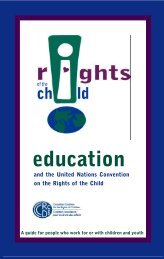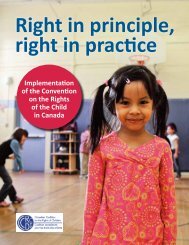Poste - Canadian Coalition for the Rights of Children
Poste - Canadian Coalition for the Rights of Children
Poste - Canadian Coalition for the Rights of Children
You also want an ePaper? Increase the reach of your titles
YUMPU automatically turns print PDFs into web optimized ePapers that Google loves.
C A N A D I A N C O A L I T I O N F O R T H E R I G H T S O F C H I L D R E N<br />
Alliance <strong>of</strong> Home Schoolers estimates that <strong>the</strong>re are<br />
approximately 50,000 students being educated at home. 168<br />
Parents can establish <strong>the</strong>ir own curriculum and choose<br />
<strong>the</strong>ir own learning materials. To support home schooling,<br />
British Columbia, Alberta and <strong>the</strong> Yukon allow access to<br />
educational facilities and learning materials. 169 In some<br />
jurisdictions, children are required to register with a local<br />
school; o<strong>the</strong>rs require that approved texts be used.<br />
Provincial monitoring <strong>of</strong> home schooling is mostly<br />
carried out by local school boards but home schooling<br />
has not generally been well defined or supported. 170<br />
Regulations are now increasing due to <strong>the</strong> growing<br />
popularity <strong>of</strong> this alternative to public schools.<br />
Private Schools<br />
Less than six percent <strong>of</strong> <strong>Canadian</strong> students are enrolled<br />
in private schools. 171 Independent private schools exist<br />
across <strong>the</strong> country and may operate in any province or<br />
territory if <strong>the</strong>y meet general standards <strong>for</strong> elementary<br />
and secondary schools. Most private schools closely<br />
follow <strong>the</strong> curriculum and diploma requirements <strong>of</strong> <strong>the</strong><br />
department or ministry <strong>of</strong> education. Alberta, British<br />
Columbia, Manitoba, Quebec and Saskatchewan support<br />
private education by providing some <strong>for</strong>m <strong>of</strong> financial<br />
assistance to <strong>the</strong>se schools. 172<br />
A private school may refuse to admit a pupil but legal<br />
mechanisms exist to ensure that private schools are nondiscriminatory.<br />
For example, <strong>the</strong> Human <strong>Rights</strong> Code <strong>of</strong><br />
Ontario protects against possible human rights violations<br />
in private schools. However it should be noted that since<br />
<strong>the</strong> <strong>Canadian</strong> Charter does not apply to private, nongovernmental<br />
action, 173 it is likely that Charter guarantees<br />
will not apply to <strong>the</strong> procedures and decisions <strong>of</strong><br />
independent school administrators. 174<br />
Charter Schools<br />
Canada has only nine charter schools, all <strong>of</strong> which are in<br />
Alberta. 175 These schools:<br />
• are sponsored by <strong>the</strong> Minister <strong>of</strong> Education;<br />
• are located in large urban centres;<br />
• have been in existence <strong>for</strong> one to three years;<br />
• have small classes, and<br />
• are experiencing a growth in enrollment. 176<br />
92<br />
According to University <strong>of</strong> Calgary research, parents see<br />
positive results from <strong>the</strong>ir children’s charter schools, such<br />
as improved academic per<strong>for</strong>mance and increased student<br />
satisfaction with learning and personal confidence; 85<br />
percent plan to keep <strong>the</strong>ir children in <strong>the</strong> charter school. 177<br />
Charter schools are not accepted by all educators because<br />
research has shown that <strong>the</strong>se schools have:<br />
• limited financial, moral or technical support;<br />
• limited pr<strong>of</strong>essional development <strong>for</strong> teachers; and<br />
• adversarial relations with o<strong>the</strong>rs in public system. 178<br />
Charter schools by <strong>the</strong>ir very make-up do not promote<br />
inclusiveness. Charter schools also have difficulties with<br />
governance, due to parents’ lack <strong>of</strong> knowledge or expertise<br />
and vaguely defined roles between administrators and board<br />
members. 179 There is also a concern about undue criticism<br />
<strong>of</strong> public schools in order to justify charter schools and <strong>the</strong>ir<br />
separate public funding. Ontario’s Education Improvement<br />
Commission rejected provincial funding <strong>of</strong> charter schools<br />
in 1997, saying it “would undermine <strong>the</strong> strength <strong>of</strong><br />
Ontario’s public education system.” 180<br />
Conclusion<br />
<strong>Children</strong>’s right to education is assured in <strong>Canadian</strong><br />
legislation, which provides <strong>for</strong> primary and secondary<br />
schooling and obliges all children to attend. Alternatives<br />
to public schooling are also permissible. Education is a<br />
provincial responsibilty and is administered by local school<br />
boards. As such, <strong>the</strong>re are variations in <strong>the</strong> provision <strong>of</strong><br />
education across <strong>the</strong> country.<br />
The goals <strong>of</strong> education generally address <strong>the</strong> developmental<br />
needs <strong>of</strong> children although special programming <strong>for</strong><br />
students is inconsistently available. Concerns have been<br />
identified about national educational ef<strong>for</strong>ts such as: <strong>the</strong><br />
reduction in education spending and its adverse effect on<br />
<strong>the</strong> availability <strong>of</strong> programs and services; <strong>the</strong> reduction <strong>of</strong><br />
<strong>the</strong> number <strong>of</strong> school boards and <strong>the</strong> impact this has had on<br />
access to programs such as special education; <strong>the</strong> high<br />
drop-out rate <strong>of</strong> Aboriginal children; <strong>the</strong> unclear status <strong>of</strong><br />
rights education and multicultural programming; and <strong>the</strong><br />
availability <strong>of</strong> instruction in both <strong>of</strong>ficial languages “where<br />
numbers warrant.”<br />
A charter school is an independent public school. A Charter school must meet broad provincial guidelines but <strong>of</strong>fers a<br />
distinct program, ei<strong>the</strong>r in its treatment <strong>of</strong> subject matter or alternative teaching methods. Charter school founders sign a<br />
charter agreement with ei<strong>the</strong>r a local school board or <strong>the</strong> minister <strong>of</strong> education in order to become autonomous<br />
administrators <strong>of</strong> <strong>the</strong> school. In return, <strong>the</strong> government provides full funding <strong>for</strong> each student.




